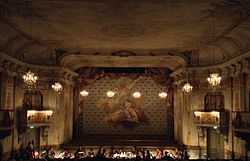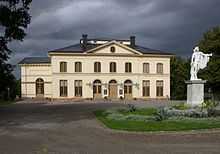Drottningholm Palace Theatre


The Drottningholm Palace Theatre (Swedish: Drottningholms slottsteater) is an opera house located at Drottningholm Palace in Stockholm, Sweden, which has been described by Per-Erik Öhrn, the theatre’s former artistic director, as "the Swedish jewel in our European cultural heritage crown of centuries-old theatres".
Currently the reinvigorated theatre has acquired a growing international reputation as a summer opera festival theatre by focusing on works by Haydn, Handel, Gluck and Mozart and emphasis on authentic performance. The theatre has also had guest performances by the Royal Swedish Opera.
Original theatre




Work began at the end of the seventeenth century under the architect Nicodemus Tessin the Elder and was completed by Nicodemus Tessin the Younger. The interior was decorated between 1665 and 1703, at first in a heavy, sumptuous baroque style, but later increasingly refined to French patterns. During the 18th century, it was used as a stage for French theatre, such as the Du Londel Troupe (1753-1771).
The predecessor to the present theatre was destroyed by a fire in 1762. The present 400-seat opera house was opened in 1766 by Carl Fredrik Adelcrantz for Queen Lovisa Ulrika. Its interior decoration is made from a mixture of stucco, papier-mâché, and painting. The stage machinery, designed by the Italian, Donato Stopani, is still intact and it includes a wave machine, thunder machine, and a flying chair which is often used for deus ex machina effects.
After the assassination of King Gustav III in 1792 (which is the basis of the Giuseppe Verdi opera, Un ballo in maschera), the theatre was forgotten.
20th Century restoration and revival
In 1920, under the direction of Swedish theatre historian Agne Beijer, it was restored with the addition of electric light, which today is designed to flicker like candles. It re-opened on 19 August 1922 and is today run by a private foundation, the Drottningholm Theatre Museum, and is funded by government and private grants.
Almost all of the equipment is original, and the stage is unusual for having a significantly greater depth than width. The operas are often performed by musicians wearing period costume, and the orchestra performs using period or copies of authentic instruments. Most productions demonstrate some of the possible stage effects using the original equipment.
In 1991, the theatre, along with the Drottningholm Palace (the residence of the Swedish royal family), the Chinese Pavilion and the surrounding park, became the first Swedish patrimony to be inscribed in the UNESCO list of World Heritage Sites. Parts of the Palace, the Pavilion and the Theatre are open to the public.
Recent Artistic Directors of the theatre are Arnold Östman (1980–92), Elisabeth Söderström (1993–96), Per-Erik Öhrn (1996-2007). Mark Tatlow (2007-2013). Sofi Lerström, the theatre's Managing Director from 2011 took over as Artistic Director in 2013.
The theatre as featured in Bergman's The Magic Flute
The interior of the theatre was originally scheduled to be featured in Ingmar Bergman's 1975 film version of The Magic Flute. However, according to film historian Peter Cowie's notes for the DVD release of the film, while Bergman wanted to recreate as closely as possible the original 1791 production in the Theater auf der Wieden in Vienna, he had hoped that the film could be shot in the theatre. Introductory exterior shots of the theatre set the scene in the film. However, "the scenery was considered too fragile to accommodate a film crew. So the stage – complete with wings, curtains, and wind machines – was painstakingly copied and erected in the studios of the Swedish Film Institute".[1]
See also
References
Notes
- ↑ Peter Cowie, "The Magic Flute". Notes on the film followed the DVD release on criterian.com. Retrieved 12 November 2012
External links
- Online site for photo of performance
- Drottningholm Theatre online at britannica.com
- Drottningholm Palace and Theatre online at The New York Times
- Theatre website in English online at dtm.se/eng
Coordinates: 59°19.384′N 17°53.10′E / 59.323067°N 17.88500°E
| ||||||